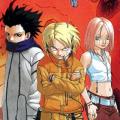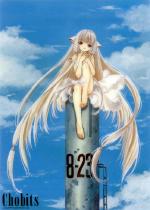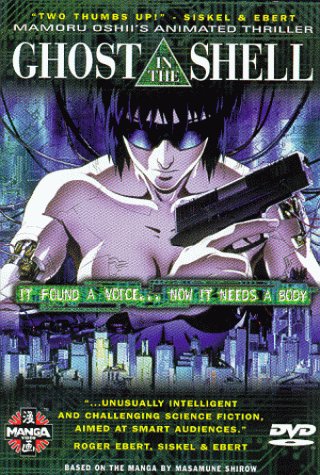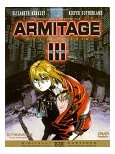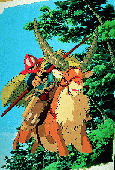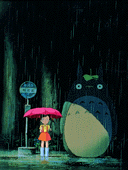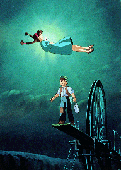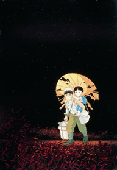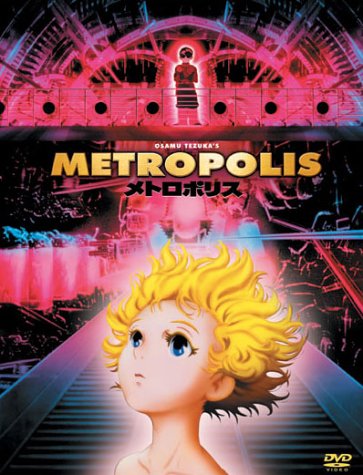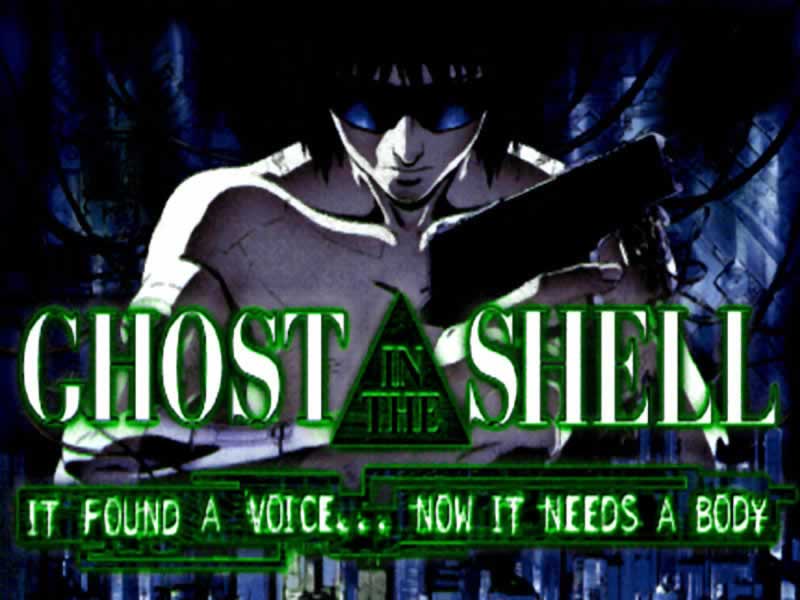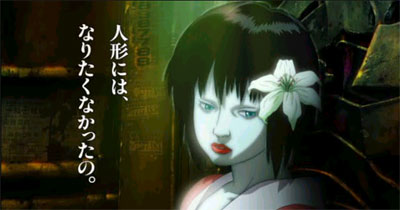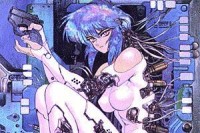| Anime:
The word anime appears in written form in three katakana characters a, ni,
me. Japanese pronunciation is anime, but in the United States speakers typically
pronounce the word as 'æn'mei and in England it is generally pronounced
æn'mi. It
has been a while (and I am a bit behind) but I am all about: From
animation to anime: drawing movement and moving drawings |
 | |
| Ghost
in the Shell - I'm hooked on anime. The movie is fantastic. Drawn in by the
similarity between Ghost in the Shell and The Matrix and Matrix Reloaded, this
stylistic exploration of an issue that constatnly defies resolution -- the mind/body
duality -- is certainly getting a strong revisit here. Ghost in the Shell is Kazunori Ito's futuristic vision where the confluence of the body (the shell) and the ghost (the mind) meets cyborg technology and all we are left with is angst. The film is certainly aimed at adults. I am new to the phenomenon of anime so I am still wondering about all the nudity and violence playing to a particular theme. My sense is that the intimate nature of man and machine and the particular threat that cyborg technology poses is considered real and immediate. Reference is made to the high maintenance nature of the cyborg and the technology in this movie. However, despite lines like "Aside from a slight brain augmentation, your body's almost entirely human" and "You're treated like other humans, so stop with the angst!" we are still confronted with the mind/body duality. Framed in a stylistic space where characters like Maj. Kusanagi run after such unlikely characters as "The Puppet Master" and similarities of movies like Bladerunner and the X-Files I can't help but grin at the irony of so "western" (and I use this word cautiously here) a consideration played out in such an "eastern" space. Despite all that, Ghost in the Shell is a cinematic event and should be treated as such. With the fertile cross polination between the east and the west, who knows, we might see a new entity which is a simulacra of the androginous characters that inhabit this genre. Am I hooked? Absolutely! Can't wait for the sequel. If you have not seen this movie -- watch it! It will change your perspective on animation entirely. | |
|
Akira (Special Edition)
- Katsuhiro Otomo produced an animated feeature which is complex, fast, and amazing.
The movie starts with the trouble that develeps when Tetsuo starts to feel uneasy
about the way Kaneda always has to rescue him. To re-iterate the obvious, the
story is set in a 21st century post-apocalyptic world of psychic forces (akira).
This almost gothic post-doomsday fantasy serves as the framework for a story that
calls to question the impact of technology as well as presenting a dim view of
the future. Akira is said to be the precusor of the bleak Evangelion series. There are a few questions that still haunt me. Is it appealing because it is edgier than most animation features or because is it seen as exotic? Along those same lines, is this sense of Otherness, the exotic nature of anime is imported and has infused western cinema a sort of western cross polination? What of the influence of anime like Ghost in the Shell on movies like The Matrix Reloaded. Has the Other become the Same? This highly detailed and often violent animation also calls to question power and corruption. To the critics who are looking for a conventional narrative, they will be disappointed - since the film is utter chaos - but that is the beauty of it. Otomo challenges us to fill in the gaps. In a stark and odd conversation between Kaneda and his female friend, the conversation turns heavy relating to the nature of Akira. Akira and the revelation of what he/she is or is not is somewhat disappointing. Yes, at the end, we still have a very vague notion for the motivations of all the characters. One of the points of the movie is to play out consequence. The movie has to be seen more than once to be fully appreciated. | |
| Armitage III - Poly-Matrix - Armitage III - Poly Matrix is in a class all its own. Almost as if it were an anime version of Bladerunner, Ross and Armitage hunt down and destroy thirds. Similar in theme to Metropolis (2001), the characters are fixers in a world of technology gone awry. It is gritty, sassy and a bit graphic and is not for the weak of heart. Much has been said about the graphics but little is mentioned about the implications of the story of a sentient robot out to destroy her own. Unlike Ghost in the Shell, which focuses on the issue of cyborgs -- this one is steeped with robot lore. As part of the big four (Ghost in the Shell, Akira, Princess Mononoke, and the Armitage series) is a necessary element to appreciating this ever changing and very dynamic genre. Hyroyuki Ochi, although creating something short of a classic, has created a thought provoking saga. | |
| Princess
Mononoke (Mononoke Hime) - It is difficult
to be profound about a movie that has been written about so much. Much of which
has been written is rather obvious. Hayao Miyazaki's Princess Mononoke, although
it is an adult oriented film in terms of complexity, it has something for everyone.
Princess Mononoke is appealing on many levels because much like other anime features
like Armitage III, Ghost in the Shell, and Akira, Princess Mononoke also confronts
the issue of technology head on. However, what is unique here is that Miyazaki
problematizes the duality of man vs. nature really expanding the problem to man
within nature and calling for a sense of co-operation. Again, While other movies
like Armitage III, Ghost in the Shell, and Akira are a shade darker than most,
Mononoke is laced with hope and reconstruction. Based on our epistemological framework we are looking for good vs. evil. We are always trying to set things up in a space of binary oppositions. Most viewers are looking to make things "simple." Juxtaposed against our longing for the simplistic, Miyazaki doesn't make judgements about good or evil. Miyazkai simply asks many questions. It is really unfair to make any direct comparison but the reason this genre is appealing to a wider audience is that this genre and the movies that are produced within it are more "realistic" than the more common Disney animations offerings. Another sub-theme is the healing power of nature which is superior to the human need to conquer and control. Susan Napier writes: "At a more complex level, films such as Princess Mononoke actually works to resist and even confront certain public stereotypes, inspiring huge numbers of moviegoers to look at some of the myths of modern Japan in a more critical way." The movie zeroes in on ecological issues, a far cry from the stereotypes we have of Japan as a giant impersonal machine. Along this same lines, the big four (listed previously) warn us just as much about the march of modernity and technology. In Princess Mononoke, it seems like Miyazaki is setting up a battle between man and nature. My sense is that it is man in nature. No doubt, this is a complex movie. The interplay between Asitaka, Mononoke and Lady Eboshi is not a simple one. Within the confines of the story, no one character is all bad or all good. All the characters are multi-dimensional and not one character is a caricature. A pivotal character is Lady Eboshi. Lady Eboshi's involvement with Iron Town is not be dismissed as trivial. How is the viewer going to reconcile Lady Eboshi's agenda and altruism? The beauty and wonder of Princess Mononoke is not so much that it provides answers but that it poses deep questions. For this reason alone (and there are many) Princess Mononoke can be classified as a work of art and it will survive the ravages of time. | |
| My
Neighbour Totoro (Tonari no Totoro) - "My Neighbor Totoro," a film
by Miyazaki Hayao is many things on many layers - one vital layer concerns loss
and coping with the real possibility of loss. Satsuki, Mei and their father move
to the countryside owing to the illness of their mother. As is common in Miyazaki
films, the film centers on the concept of Shojo. According to Susan Napier, ""Shojo"
literally means "little female" and originally referred to girls around
12 and 13. Over the last couple of decades, however, the term has become a shorthand
for a certain kind of liminal identity between child and adult, characterized
by a supposedly innocent eroticism based on sexual immaturity, a consumer culture
of buying "cute" (kawaii) material goods, and a wistful privileging
of a recent past of free-floating form of nostalgia" (Napier, Anime From
Akira to Princess Mononoke 118). I will do 3 things in this review: (a) Picking
up on Napier's shojo definition in terms of its liminality, (b) I will explore
the space between supernatural vs. the fantastic, leading into, (c) an examination
in terms of magical realism and the emancipation through flight. Residing in this liminal shojo space has really less to do with Mei but more to do with Satsuki. As the crush of the rather nervous young neighbor, we are introduced to Satsuki in a voyeuristic fashion. We "know" the young neighbor is somewhat smitten by her and yet she seems oblivious to the whole thing. This sort of "innocent eroticism" is played out - arguably to hint that Satsuki is well on her way to becoming a woman - but not yet. As Mei is left to her own devices, she chances on the bucket with the hole and eventually finds herself falling into the hole in the camphor tree - where she finds Totoro. The wonderful thing about Anime is that the transitions between the real, the surreal, the fantastic and even the magical realism is so seamless as to appear natural. As Mei, in a move reminiscent of Alice in Wonderland stumbles into a rabbit hole of sorts, finds herself in the realm of the unreal, or is it? When she is found in the forest by Satsuki - in a really imaginative move, Miyazaki keeps Satsuki in the liminal shojo space by making her see the things that only children see. We get this, in a real sense, when the cat bus is approaching both Totoro and Satsuki and she wonders how come no one else can see. Even if the father "believes" both Satsuki and Mei - he never really "sees" anything. Is the experience of Satsuki and Mei merely a hallucination or is it something supernatural. Once again, to borrow from Napier, something "supernatural" is still within the realm of the real. Taking the tack that the movie is about stress and children inventing realities to cope with such stress, Napier describes a facet of Miyazaki's work - that of the realm of the "enchanting" (Napier, Anime From Akira to Princess Mononoke 126-132). Back to the original premise of transcendence from that liminal characteristic of shojo... I find myself transported back to Milan Kundera who writes in "The Book of Laughter and Forgetting": "And then suddenly they were all singing the three or four simple notes again, speeding up the steps of their dance, fleeing rest and sleep, outstripping time, and filling their innocence with strength. Everyone was smiling, and Eluard leaned down to a girl he had his arm around and said, "A man possessed by peace never stops smiling." And she laughed and stamped the ground a little harder and rose a few inches above the pavement, pulling the others along with her, and before long not one of them was touching the ground, they were taking two steps in place and one step forward without touching the ground, yes, they were rising up over Wenceslaus Square, their ring the very image of a giant wreath taking flight, and I ran off after them down on the ground, I kept looking up at them, and they floated on, lifting first one leg, then the other, and down below - Prague with its cafes full of poets and its jails full of traitors, and in the crematorium they were just finishing off one Socialist representative and one surrealist, and the smoke climbed to the heavens like a good omen, and I heard Eluard's metallic voice intoning, "Love is at work it is tireless," and I ran after that voice through the streets in hope of keeping up with that wonderful wreath of bodies rising above the city, and I realized with anguish in my heart that they were flying like birds and I was falling like a stone, that they had wings and I would never have any." I intuit a sense of escapism in Miyazaki's work. I think there is something to Miyazaki's movies in terms of escape - from the everyday to a liberating space. On the subject of liberation... it is common to see flight in Miyazaki. "Laputa" we see nothing but flying. In "Kiki's Delivery Service," it is arguably learning to fly that liberates Kiki. Miyazaki's oeuvre is filled with imagery of flight - Tonari no Totoro is no exception. To transcend being human, being a child, as Kiki escapes her liminal status as shojo and into womanhood so does Satsuki as she and Mei take flight in the cat bus. And I "realized with anguish in my heart that they were flying like birds and I was falling like a stone, that they had wings and I would never have any." | |
| Laputa:
Castle in the Sky (Tenku no Shiro Laputa) - Miyazaki Hayao's Castle in the
Sky is perhaps the most difficult but rewarding movie to watch, to contemplate
on and to share one's thoughts about. Castle in the Sky is really a manga movie
and not just your garden-variety animation offering either. Castle in the Sky
moves forward on many levels and yet it pulls back on others. Castle in the Sky
in a sense is trapped in its own circularity. Moreover, Miyazaki is a master at
playing with the aesthetic of weightlessness. He uses 'natural elements' like
the wind in place of a more mechanical source. Miyazaki compels us to consider
the plundering of nature. He, moreover, asks us to pause and to reconsider man's
need to conquer nature as well as the misuse of technologies. Like Sheeta we grapple
with our own weightlessness, our own significance. Castle in the Sky provides a sustained and critical assessment of our attitudes toward technology. Effectively this generation has inherited what technology it currently uses and lacks discipline and appreciation of the impact of our use of it. In moves similar to those made in Princess Mononoke, it is not so much technology that is the issue but rather the use (or misuse) we subject it to. The enemy is not technology but rather our use of technology that calls us to question our ideas on progress. In a sense, it could be argued that Miyazaki is nostalgic for a bygone era - to return to that zero point when we did not have technology on this scale. As mentioned previously, although less pronounced than Princess Mononoke, both stories converge in their subtle but sustained critique of progress and technology without really being a Romantic elegy of lost innocence. In this sense most anime can be seen to be exploring some postmodern themes -- but in my opinion only Princess Mononoke sustains a postmodern argument. Moreover, as a general rule anime takes into account issues of movement into its scenarios and players and the solutions are varied, of course, depending on specific anime sub-genre. However, there looks to be an overall tendency away from mechanical sources to sources of a more organic genesis. Although the use is more pronounced in Miyazaki's work, it is evident in the Cyborg and Mecha anime such as Ghost in the Shell, Akira and Armitage (all available on Amazon.com). It could also be argued that both Castle in the Sky and Nausicaa of the Valley of the Wind are in a sense post-apocalyptic. In this sense most major anime offerings including: Barefoot Gen and Grave of the Fireflies calls to question the use of technology for destruction and ultimately domination. Miyazaki explores his Romantic notions by not only critiquing the use of advanced technology but by setting this movie in the early nineteenth century. The flying vessels all hearken back to a bygone era making the movie's signs almost period. This back and forth between technology and the bygone era disrupts a linear narrative making it, and I say this guardedly, postmodern. Miyazaki's calling to the question the undisciplined use of technology elevates the movie beyond a good and evil bifurcation. Miyazaki calls to question the destructive force of unnatural creations and for domination by its users makes this (and all his other movies anything but trivial. The truth is, robots and similar technologies, are not in themselves the problem. It is rather to what use these implements are put. In anime we see moving scenes of robots protecting nests, befriending little animals as well as tending gardens as if we ascribe to these non-sentient beings the best of our qualities. Conversely, anime does not shy from the frightening scenes of the very same machines tearing up the countryside. With the juxtaposition, perhaps the mood is set to have us consider a back to nature approach. Before I close, I wish to deal with the issue to the tragic and epic hero in Castle in the Sky. My sense of it is that Sheeta is, in a sense the epic heroine of the story in her reluctance and almost passive role in the movie. Castle in the Sky is steeped in an experience of floating, gliding and soaring -- hence weightlessness. Sheeta's flying stone is a passive tool in that it prevents her from falling. Sheeta does not fly. In Miyazaki's work -- like My Neighbor Totoro and Kiki's Delivery Service flying is a way to achieve weightlessness. Here, Pazu is the one who seeks to soar -- making him seem somewhat of an active but tragic hero. Flying is a key element in Miyazaki?s films and it is the flying machines that are less mechanical and more organic that are privileged. Optimizing the energy in nature is the desired configuration. Miyazaki is one that will survive the ages because his creations are very challenging but nonetheless accessible. Castle in the Sky is hinged on the prospect of a world prior to technology making the movie, at the risk of sounding condescending, anything but trivial. | |
| Grave
of the Fireflies (Hotaru no Haka) - The narrative of Grave of the Fireflies
is simple but the messages behind the anime are plentiful and profound. Based
a semi-autobiographical novel by Akiyuki Nosaka - Hotaru no Haka centers around
two children Seita and his 5-year-old sister Setsuka. Rendered homeless by the
fire bombing in Kobe and practically orphaned -- their father is serving in the
Japanese navy, while conversely, their mother is a killed in the bombings. For
the better part of the movie an aunt takes care of both of them - for a price.
Seita gets the sense and then it is overtly displayed that both he and Setsuka
are not really welcome. Seita endeavors to hit hills, to a cave which they make
home. Seita scrambles for food - using anything he can find and then eventually
deteriorates to stealing. The opening of the film is Seita dead in a subway station,
and so we can deduce Setsuko's fate; we get the details by fallowing his flashbacks. Grave of the Fireflies is many things - primarily the tone would be one of sadness. It is a deeply emotional experience. Having said that, it really sets the tone for the story. Right of the bat, one gets the sense of catharsis, as if the writer of the story is trying to assuage his guilt. Loosely based, as previously mentioned, on Akiyuki Nosaka's war experience (wherein he loses his sister) we are certain to be touched by film's more serious themes - in more ways than one. One gets the sense that the movie is designed to elicit sympathy - hopefully for the universal condition of the toll that war extracts. If I was not moved by it I could not count myself among the humane. As much as it serves to remind us of the suffering in Japan, let this not also blind us to the suffering caused all around Asia - both to and by the Japanese. There is no doubt that the film is profoundly human. Yes, on another level it is a story of survival. Director Isao Takahata (and Akiyuki Nosaka, of course) compel us to meditate on the suffering in war, the futility of war, and that the most innocent are the ones who suffer most. Cognizant that these are the musings of Akiyuki Nosaka - I am less able to focus on the bigger questions. I am not taking anything away from Grave of the Fireflies - both in terms of the depth and the quallity of the animation. I love the meditative tone and even fell for the scene that took place one evening when the children capture the fireflies and use them to light the cave. If my memory serves me right, this is the same scene that Setsuka asks Seita about death. On the very next day, Seita finds Setsuka burying the dead fireflies and images of the dead mother flash quickly. Let us not fall into a sense of selective amnesia by choosing to remember one but in so doing tacitly forgetting the others. One could argue that by focusing on the suffering in Japan, the filmmakers are part and parcel of a discourse of victimhood. In war everyone is a victim. | |
| Perfect
Blue - A movie like this makes us question the limits of our own consciousness.
It allows us to explore in a space not our own, the endless possibilities and
the demons lurking within the human psyche - and alerts us to the reality of what
it is we do not know. We should be scared of what we are capable of, not to mention
to celebrate our potential. One of the good things about anime is that the simulation
seems less real, since it is in this "invented" space. I'm not trying
to downplay the effect - as I feel that the impact on the viewer is no less real
- just merely stating an observation. Lett this not fool you, I am not that naïve
- anything in cinema is a simulation, sommetimes a simulacra, of reality. However,
despite the impact being as real, the images - no matter how explicitly sexual
or graphically violent - are not as "real" as in motion pictures. I
most certainly don't expect too much of a buy-in on that last comment. However,
images seem more sanitized and we don't need to spend so much of the budget on
scenes and the potential for good is astronomical. I guess that is why I endorse
this genre. I'm as confused about the sexuality and violence as anyone. The Jody
Fosteresque traumatic rape scene (ala The Accused) borders on the exploitive.
Perfect blue flirts beyond anime at times bordering on hentai. The story is a simple one but the execution is not. Mima Kigiroe is a struggling entertainer with a bevy of loyal fans. She starts her career as a singer and transitions into a career in acting. Her entrée into this world is a series called Double Bind - of which the subtlety was not missed on me. As yes, the seemingly disjointed story evolves, Mima (as well as the viewers) reality begins to collapse. I have to admit, I was lost several times while watching the movie, about what was reality and what was fantasy, as if the writer purposefully wanted me, the viewer to emulate the sense of utter confusion that Mima was going through. Was it successful? Absolutely! Anyway, coupled with the ever present updates on a website called Mima's Room - we are presented with (as Mima is) withh several apparitions. Mima is forced to utter (in a moment of epiphany) that someone sure knows her. For the resolution (or lack thereof) you will need to watch the movie yourself. What is really "cool" about Perfect Blue particular anime is that it does not fit into one of the many popular categories of anime already out there. It neither fits into the post-apocalyptic strata of an Akira or Ghost in the Shell nor is it romantic (in the Byronian sense) as say something coming out of Hayao Miyazaki. Perfect Blue cuts new ground. Japanese have, for a long time, been interested in psycho-thrillers and the good detective story. What with the popularity of writers like Matsumoto Seicho (Points and Lines - also available on Amazon.com) as well as Sogo Ishii (Angel Dust - also available on Amazon.com) is proof positive of the popularity of mystery and suspense. Make no mistake it is an adult psycho thriller. Having said all that, I am hopeful that this movie is not representative of modern Japan. As a critique of the excesses of voyeurism as well as the sadistic and misogynistic excesses of some manga, Perfect Blue stands head and shoulders above all the other anime features. Is it reflective of Japanese pop culture? On what ground and under what context, that still has to be further explored. Not to belabor the point, for the resolution (or lack thereof) you will need to watch the movie yourself. | |
| Metropolis
(2002) - Much has already been written about the contribution of Katsuhiro
Otomo of Akira fame. The influence is obvious. However, the unique quality that
Hayashi Shigeyuki brings into the equation is the fusion of Ridley Scott's Bladerunner,
Fritz Lang's Metropolis, Osamu Tezuka's manga, and of course Katsuhiro Otomo's
Akira. The fusion of all these almost seemingly unrelated sources is nothing short
of a classic in the making -- and it should be considered as one. I'll tell you
why... The first thing anyone with guts enough to pen a serious review needs to do is to admit his/her bias. I was drawn into this genre by Ghost in the Shell so understandably, almost everything I watch is measured against this standard. In terms of plot and character development, few anime come close to Ghost in the Shell -- but that is my bias. In terms of being visually stunning and a sense of geniune displacement (an effect that most of these post-apocalypse anime features have on me) Metropolis is second to none. No doubt, the visuals are stunning. Akira may have had the grit, Ghost in the Shell or Princess Monoke may have had the character and plot development -- but none could have come close in terms of impact with that move of playing "I can't stop loving you" juxtaposed along the destruction of the Ziggurat like structure that looms large on almost every scene in the movie. I'm taking a different approach here -- Metropolis has the same impact on me -- not so much as Blade Runner had but more akin to Ayn Rand's modernist epic The Fountainhead (1949) and Rock reminds me more of Howard Roarke than he would a Deckard or even a Tesuo. I'm not looking for hidden symbology -- more like an experiential thing... > The art deco theme is nothing short of spectacular. It was the look the drew me in. Hard to compare other anime features as each on has its own "thing" to contribute -- each one is unique. Metropolis has a truelly different aethetic feel to it. However, much like all the other films that preceded it, including films by Hayao Miyazaki -- Metropolis calls to question the rise of technology and the eventual inclusion of robotics into our everyday milieu. Just like Bladerunner -- the tendency is to see technology as a double edged sword -- with a real potential to go rogue. No less disturbing is the almost subtle allusion to a real sense of separation between corporate giants and the little person. Along that same problematic is a solution steeped in toppling the bigwigs through a revolt or uprising and an almost fatalistic turn towards some form of terrorism. Is this really our fate? Do we really need to resort to violence to gain some form of agency? I would like to think these movies are cathartic in nature and give us something positive to think about. They all do give us something to think about. Besides, what could be better than escaping into a stylistic world of art deco and ragtime. As fragmented as these stories are, they always seem to come to some sort meaning -- as many meanings as there are viewers. | |
| Tokyo Godfathers DVD ~ Toru Emori: Tokyo Godfathers is certainly not your run of the mill Anime. The plotline however is straightforward - Tokyo Godfathers is touching story of three homeless people: Gin (a down on his luck wino), Hana (a past his/her prime homosexual drag queen) and Miyuki (a runaway adolescent) - who come across a cast off baby and seek out the child's parents from clues they uncover. In the process of finding the parents, they inevitably turn around full circle and find themselves... and we in turn, ourselves. Appropriate for any Christmastime - it is set in a snow-covered metropolitaan Tokyo. The movie is full of coincidence and has a feel of modern-day inner-city fairy tale. The movie is described as a comedy but the serious underpinning of urban angst pervades the scene. Subsequent to finding the toddler in the midst of a heap of rubbish, our three anti-heroes go about their business - while battling their demons - in a classical gumshoe fashion. Despite the many diversions into sub-stories such as gangland rescues and such, it is clear from the outset that the key to understanding the characters is the road home. As can be predicted with most fairy tales - even urban ones - there is a miracle or two. Moreover, ass with redemption type stories there will be the inevitable reconciliation of parent to child - and Tokyo Godfathers is no exception. Part of Tokyo Godfather's charm is its ability to make social commentary amidst the comedy of errors - themes such as economic disparity and Foucauldian alienation or othering is all over the movie. Nevertheless, the key to investing in the movie is the complexity that Anime brings with it - a sense of transformation. That the characters where one way when we began and are very different now - just as we were one way when the movie began and effect a metamorphosis in the end. We share the experience of Gin, Hana, and Miyuki because it is cathartic and we can explore this in this imagined space... others are not so fortunate. | |
| Ghost
in the Shell 2 - Innocence DVD ~ Akio Ôtsuka: In 2004 we saw the release
of Ghost in the Shell 2: Innocence - taking the original Ghost in the Shell theme
that set the stage for a cyberpunk revisit that revolutionized the movie industry.
Ghost in the Shell 2: Innocence does not disappoint, it cranks it up a notch,
or two. Situated in year 2032, the Innocence pick up again several years after
the original Ghost in the Shell - the new movie remains true to the same existential
questioning that the previous movie posited: What is it to be human? In Innocence
humans and cyborgs once again share the same space. The line that divides the
purely organic from the hybrid machine beings is now blurred even further. The
mis-en-scene is once again dystopic. Bateau is once again problematic because
he exist along side us and blurs the distinction between man and machine. As a carry over from the first movie, the movie focuses on Bateau of Section 9. Completely cyborg, he is joined existentially to his former partner, Motoko Kusanagi. Togusa fills the partner void left by Kusanagi and is the true counterpoint to Bateau - fully organic - he is the closest thing to `human' in Section 9. The early part of Innocence focuses on the trivial - the mundane, the everyday. Quickly the deliberation changes to higher existential issues - why were the `gynoids' sent to assassinate all these top-level officials? What started out as a routine case turns out to be something different. Aramaki - the enigmatic chief of Section 9 bringss Bateau and Taguso into the mix - they wonder why Section 9 is called into this sort of thing... Aramaki, true to form, wonders if this is a terrorist plot - something related to the Puppet Master of the old days. To reference the original Ghost in the Shell, were we first encountered self-preserving mechanized entities like Kusanagi and Bateau human parts are rendered obsolete. The real issue, though is the development of a free radical consciousness coupled with that a propensity for destruction. 2004 also saw the release of CASSHERN - which introduced that same sense of tecchnology gone awry. Innocence relentlessly ponders the possibility of technology gone rogue and we lose control - what now? Each move forward along this road of modernity - that quasi Hegelian move to that Utopic end point that modernists foist. We look into the mirror and we see something and animals, well, what do they `see' - we don't know and humanity, if we follow the modernist paradigm is still in its `Innocence' stage. No doubt the animation in Innocence is state of the art and has somehow raised the bar on anime while still staying true to is existential deliberation. Innocence carries on with the tradition that drew folks like me to become loyal to the genre - the existential angst. | |
| Crying Freeman - Portrai of a Killer (Vol 1): In an odd sense of cross cultural symbol mixes, Crying Freeman both exploits old stereotypes and develops new ones. Crying Freeman, although it may not have been intended to be so, is the reverse of Kill Bill - where a Japanese 'woman' takes over a Japanese Yakuza operation. The Chinese triad 'family', the 108 Dragons, is looking to develop its area of operation into Japan. In Portrait of a Killer and Shades of Death, the Japanese law enforcement is resolute to keep them out by forming an alliance with the local Yakuza to thwart any Dragon efforts. Yo Hinomura, a potter - is recruited by the 108 Dragons, who develop him into a killing machine. Yo completes the transition by taking the Chinese name Ron Tayan (Dragon Sun). In the opening scene, Emu Hino, a young artist, contemplates her death as she witnessed Tayan's handiwork when he assassinated a Yakuza victim and is moved to tears - ergo the Crying Freeman. Tayan, who acquired the nickname "Crying Freeman," is ordered by the 108 Dragons to get rid of the witness Emu Hino. Emu, worried for her virginity, beseeches Tayan not to let her depart this life a virgin. The love that results from their encounter causes Tayan to break a few cherished Dragon tenets. Tayan and Emu flee their Yakuza enemies and escape to safer China. The wedding of Tayan to Emu and his subsequent installation as head of the 108 Dragon causes much stir among the old guard. This DVD therefore sets the stage for the whole series - the Crying Freeman a Japanese potter at the helm of a Chinese clan. Crying Freeman is, arguably, guilty pleasure anime. Anime is, by its very fabric escapist. The problem with Crying Freeman is that it is indeed violent and is not for children. I am not certain what sub-genre it falls under but it certainly is complex and it does call to question cultural representations. At the core of the series is 'contradiction.' Yo (Ron Tayan) is enigmatic in that he kills yet is inexplicably saddened by the act. Never able to reconcile his love and position both he and Emu (now Fu Ching-Ran (Tiger Orchid)) are destined to take their happiness where they can get it. I like the series because it is a wonderful laboratory for cross cultural representation and misrepresentation - the action is simply gravy. In the darkk tradition of Perfect Blue, Crying Freeman uses sex and violence to add complexity to the story. Does the series border on Hentai - certainly a good argument could be made, in reality it is adult anime more 'R' than 'X' - I give it the thumbs up for the artistry and complexity, the rest the viewer will have to decide on their own. | |
| Crying Freeman - A Taste of Revenge (Vol 2): A Taste of Revenge takes up from where Portrait of a Killer left off. After embracing the new incarnations as Ron Tayan and Fu Ching-Ran, both Freeman and Emu Hino mature into their new function at the helm of the 108 Dragons family. In this two episode DVD we quickly move away from character development and segue into a new set of villains in The Horn of Africa - a group personally invested in the eradication of the 108 Dragons. The Horn of Africa send an envoy to the 108 Dragons heavily guarded ship with a valise full of money. The gang remising in their duty to thoroughly search this impostor suffer the consequences. The courier quickly eliminates all of the Ten Planets who function as a human shield - making Freeman's life more precious as many have been sacrificed to save him. This killing spree exposes the vulnerability of 108 Dragons - of which Freeman is bound to develop A Taste for Revenge. Once again, the question of excess violence rears its ugly head. There are copious sex scenes as well as the violence that should factor in the viewer's choice to stay with the series. I personally did not enjoy this DVD as much as the first one - of which there was more character development and plot. Crying Freeman is unique in its style and cross-cultural representations - yet again. In this volume we see crass representations of Africa as cesspool of violence. Then again, there is no place in the Crying Freeman series that is not a cesspool of violence. I say enjoy it for the freshness and uniqueness it brings to Anime. | |
|
Crying Freeman - Abduction in Chinatown (Vol 3): Abduction in Chinatown is perhaps the most powerful in terms of stereotypes but not in story and plot. In the first of the episodes, Abduction in Chinatown Freeman meets Nina. Nina is a little freak that has fantasized over Freeman from the first moment she saw him. The plot thickens when Freeman levels the rival gang with Nina at the helm. The second installment in the series, The Russian Connection, brings to presence yet another set of stereotypes - the brutal Russian mob. The whole seriees up to this DVD is somewhat characterized by deterioration in terms of storyline but an improvement in animation. The scenes become more vivid while the characters more cliché... The most interesting bit of the animation is the loyalty to its manga roots. There are distinctive, clear lines on each character - but the characters themselves remain void - almost tepid. As I segue from here to the much-anticipated live action feature, I begin to feel a sense of trepidation and excitement - but mostly ambivalence. Making the jump from Anime to live action can be tricky. What with all the special effects moviemakers have at their disposal, the live action version promises to redeem this series that showed so much promise from the outset. |

| Manga: Sometimes confused with anime,
manga is the Japanese word for comic book (or Graphic Novel, if you prefer) and
is used in English to mean Japanese comic books. Manga and anime are very closely
related, as artists frequently crossover, as do the characters they create. Usually
the manga is created first, and if it becomes really popular then the market it
deemed capable of supporting a much more costly animation based on it. Source: http://web.cs.mun.ca/~anime/afs/animdict.html |
 | |
|
Ghost in the Shell: Dark Horse
Comics Version: I came to the Dark Horse Comics version of Ghost in the Shell
a little late in the game - so it is like I am coming home. In this edition we
familiarize ourselves with the key characters and the evolution of Section 9.
We are introduced to Aramaki rather early on - who heads Section 9 and of course
to cyborgs Major Motoko Kusanagi and Batou as well as the all too human Togusa.
I was effectively visiting the archive where it all began. As evidenced in both
Making The Matrix, in The Matrix DVD and Scrolls to Screen: The History and Culture
of Anime -- in the Animatrix DVD; we hear Producer Joe Silver uttering that the
genesis of The Matrix, in large part, can be found in anime -- in particular Oshii
Mamuro's anime of this, Shirow Masamune's manga Ghost in the Shell. Manga is sometimes
confused with anime. Effectively, to the uninitiated, manga is the Japanese word
for Graphic Novel. Manga and anime are intrinsically interrelated, as artists
regularly cross-pollinate, as do the characters they create - case in point this
Ghost in the Shell manga transformed into the ever-popular anime standard and
its subsequent sequel Ghost in the Shell 2: Innocence. More often than not, the
manga is produced first, and if the popularity merits it is transformed into anime
- as was the case here. In examining the movie I articulated that Ghost in the
Shell was Kazunori Ito's futuristic vision - now I am certain that it all feeds
in really from Shirow and not anyone else. In Shirow's manga begin to see the
development of the confluence where the body (the shell) and the ghost (the mind)
meets cyborg technology. The manga, I hope is aimed at adults. I am still wondering
about all the nudity and violence playing to a particular theme. My sense is that
the intimate nature of man and machine and the particular threat that cyborg technology
poses is considered real and immediate. In the world of Ghost in the Shell, however
translated and articulated through this very hyper sexualized forms and extremely
violent episodes, lies a very profound question waiting to be answered - when
machines learn to feel who decides what it is to be human. |


